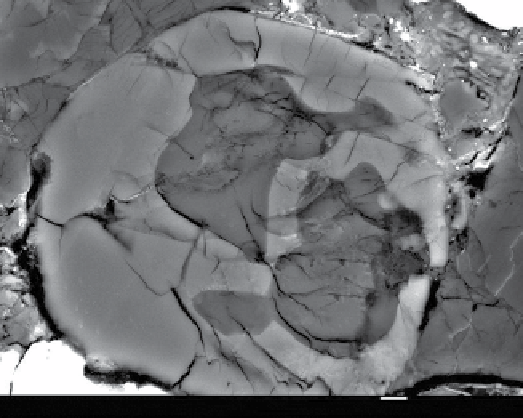Geology Reference
In-Depth Information
CH chondrite
11.922 g
Found December 19, 1985
1.5 × 2.0 × 0.8 cm
Weathering = A/B
cryptocrystalline), a significant amount of metal, some small CAis, and
little to no matrix. The zoned metal grains in CH chondrites are thought
to have formed from condensation from a gas of solar nebular composi-
tion. in addition, some CH chondrites contain nitrogen isotopic anom-
alies that are associated with insoluble organic matter.
Kus
Kus
Gro
Tiku
Gro
Kus
Tiku
COMPO15.0kV
×6,000
1
µ
m
WD 9.0mm
Other gaseous species
Fassaite ss Grsm
T4P
1.0
AlOH(g)
Ku
0.8
Melilite ss
Ge
An
0.6
Al(g)
0.4
Solar gas
C,O,H - AP 01,02
p
tot
=10
-3
atm
Aluminates - B 83
0.2
Spinel
MA
Hib
CA
6
Cor
A
Grss
CA
2
Hib
CA
6
Grss
CA
2
CA
0.0
1300
1400
1500
1600
1700
1800
T(K)
Plate 24
MiNERALogy
SigNiFiCANCE
FeNi metal (36%), lithic and silicate mineral fragments
(56%), chondrules (4%), and matrix lumps (4%). olivine
fayalite component is mainly 1% to 6% but can be as high
as 30%.
ALH 85085 was the first of this kind of carbonaceous
chondrite to be recognized, but by 2012 there were close
to 23 CH chondrites in world collections. osbornite was
documented here (left, center panel, [151]) and also in
Stardust sample collection, hence spurring links between
meteorites and cometary particles. Also, the new mineral
kushiroite was discovered in ALH 85085 (upper right,
[147]). it is a Ca,Al-silicate (CaAl
2
Sio
6
) that is part of
condensation sequence (see “Ku”) in nebular condensation
(lower right, [145]).
References [138-153]





